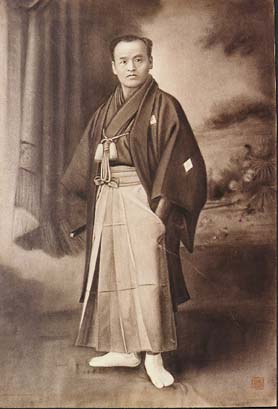Takeda Sokaku, Reviver of Daito-ryu Aiki Jujutsu
Copyright © 1997 Daito-ryu Aiki Jujutsu Hombu/Kondo Katsuyuki

Takeda Sokaku
In 1873, Sokaku traveled with his father to the dojo of his father's friend, swordsman Sakakibara Kenkichi. There he stayed on as a live-in student and immersed himself in studying the Jikishinkage-ryu. At the Sakakibara dojo Sokaku had opportunities to meet and train with many of the top swordsmen of the day, many of whom had formerly been members of the Tokugawa shogunate's Kobusho, the exclusive martial arts school for government retainers. He studied diligently, and eventually mastered many different skills and weapons including sword (ken), staff (bo), half-bow (hankyu), short-staff (jo), and throwing darts (shuriken). Later he also received a license (inka) in the spear arts of the Hozoin-ryu.
Sokaku traveled around visiting dojos throughout Japan, testing and polishing his martial skills wherever he went. He also deepened his spiritual connections through constant visits for prayer, devotions, and ascetic training to sacred places such as Udomyojin in Kyushu, Mt. Futara in Nikko, and Mt. Haguro in Dewa Province (now Akita and Yamagata prefectures). His sword skills were unparalleled and he was feared as "the Little Tengu of Aizu" (a tengu is a type of long-nosed demon; they are renowned for their martial arts skills).
In about 1875, rumor reached Sokaku that Saigo Takamori had launched his rebellion in Satsuma against the forces of the new Meiji government. He decided immediately that he would go to lend his support. He made it as far as Kyushu but was unable to reach his destination, so he returned to Osaka where he spent the next ten years as a guest in the Kyoshin Meichi-ryu dojo of swordsman Momonoi Shunzo.
Sokaku learned Daito-ryu from his father Sokichi, but it was from Saigo Tanomo, former Chief Councilor of the Aizu domain, that he learned oshikiiuchi. After the Meiji Restoration in 1868, Saigo Tanomo had become a Shinto priest and taken the name Hoshina Chikanori. In 1875 Sokaku visited him at Tsutsukowake Shrine in Fukushima to study for entrance to the priesthood, and while he was there received instruction in the arts of oshikiiuchi from Chikanori. Although Sokaku decided not to become a priest, he visited his mentor many times after that, and under Chikanori's instruction is said to have perfected seemingly miraculous skills of understanding another's mind and thought, and to have grasped the true depths of oshikiiuchi. On May 12th of 1898 Chikanori presented him with a single poem, inscribing it in Sokaku's enrollment book. One interpretation of Chikanori's words is that he is likening the flow of a river to the flow of time. With the beginning of the Meiji period, the age of the sword had ended, and no matter how skilled a swordsman might be, he can no longer make any mark and will amount to nothing. Therefore, it is time to pursue and make your way with jujutsu.
With this, the formal succession of Daito-ryu aiki jujutsu was assured. From that time on Sokaku identified himself as a practitioner of both Daito-ryu aiki jujutsu and Ono-ha Itto-ryu. He traveled around Japan teaching both arts and came to be recognized as the reviver (chuko no so) of the Daito-ryu.
Sokaku was not a large man--he stood no more than 150 centimeters tall--but his eyes were piercing and his techniques were of an almost supernatural level. He is said to have been able to sense a person's past, present, and future even before being introduced. Among his more well-known students were Saigo Tsugumichi, Hokushin Itto-ryu swordsman Shimoe Hidetaro, and Aikido founder Ueshiba Morihei, as well as army and navy officers, judges, police, martial artists, and other prominent individuals. He is said to have taught as many as thirty thousand people during his life, the signatures and seals of whom are all entered in enrollment books that are preserved to this day.
In his later years Sokaku focused his activities in Hokkaido. He passed away on April 25, 1943 at the age of eighty-three while teaching in Aomori Prefecture.